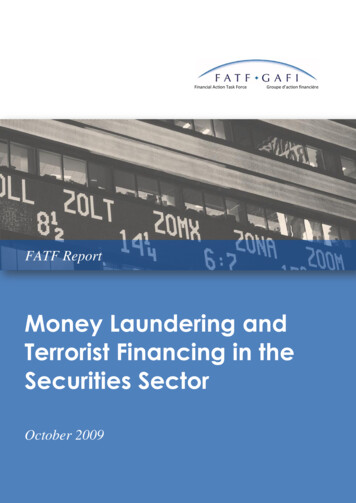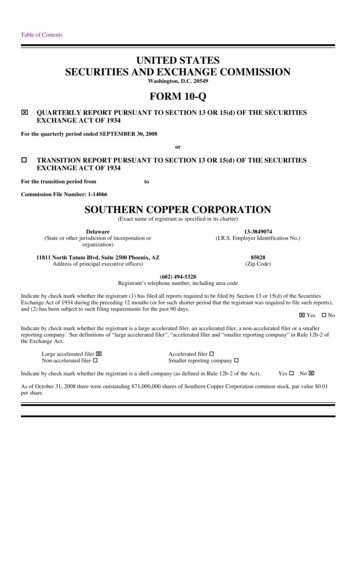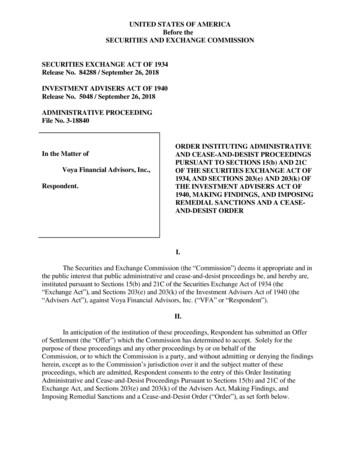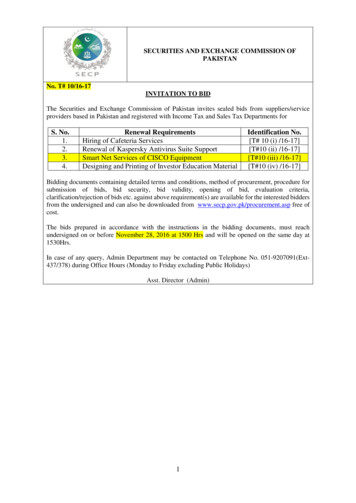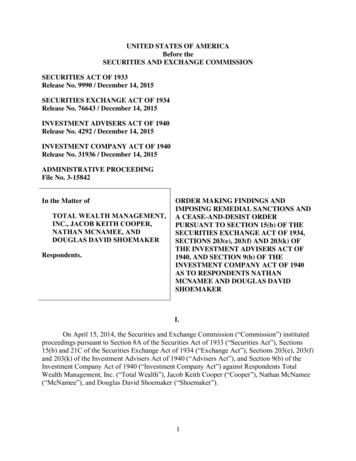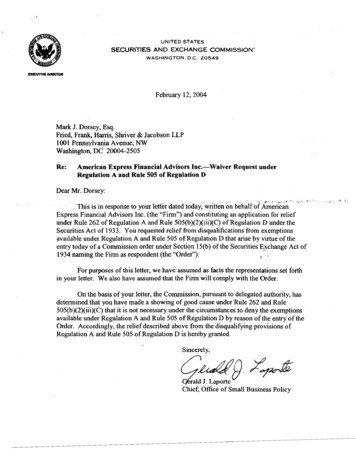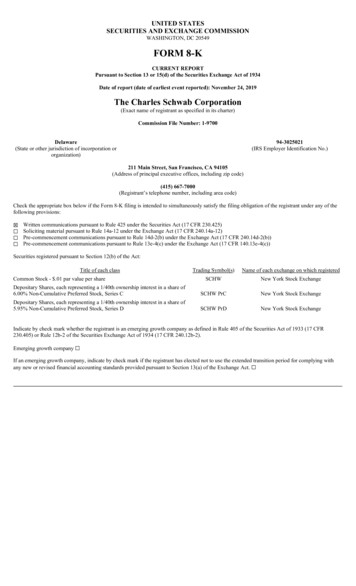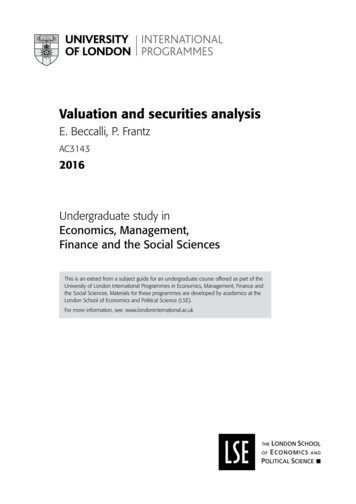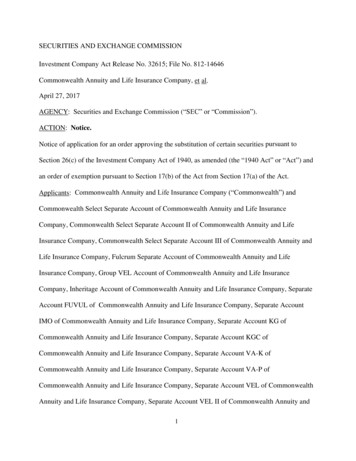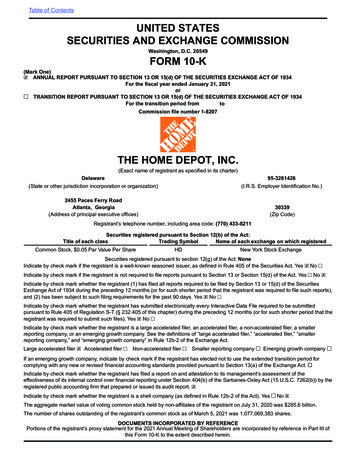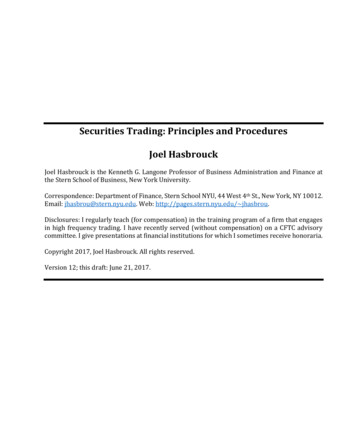
Transcription
Securities Trading: Principles and ProceduresJoel HasbrouckJoel Hasbrouck is the Kenneth G. Langone Professor of Business Administration and Finance atthe Stern School of Business, New York University.Correspondence: Department of Finance, Stern School NYU, 44 West 4th St., New York, NY 10012.Email: jhasbrou@stern.nyu.edu. Web: http://pages.stern.nyu.edu/ jhasbrou.Disclosures: I regularly teach (for compensation) in the training program of a firm that engagesin high frequency trading. I have recently served (without compensation) on a CFTC advisorycommittee. I give presentations at financial institutions for which I sometimes receive honoraria.Copyright 2017, Joel Hasbrouck. All rights reserved.Version 12; this draft: June 21, 2017.
[Blank Page]
iPrefaceThis manuscript is a set of draft teaching notes for a one-semester course entitled Principles ofSecurities Trading. The target audience is finance students planning careers in trading, investment management, or law, and information technology students who seeking to build tradingand investment systems. The exposition draws on general economic principles, with an institutional focus on US equity markets.The high level of institutional content underscores the realism and currency of the material.Given the speed with which markets evolve, however, it is likely (maybe even certain) that someof the details are out of date.By way of full disclosure, I regularly teach (for compensation) in the training program of afirm that engages in high frequency trading. I have recently served (without compensation) on aCFTC advisory committee. I give presentations at financial institutions for which I sometimes receive honoraria.Although these notes draw from the subject generally known as market microstructure, theycertainly don’t fully cover the field. There are many important areas of academic research thatare barely touched upon: the econometrics of high-frequency data; measurement of liquidity; liquidity risk and commonality; liquidity and asset pricing; empirical analysis of price discovery;and so on. These omissions reflect the priority placed on simplifying the foundations of the subject, rather than discussing all the extensions.The text is organized in parts (broad themes), chapters and sections. Part I starts with the basics. It introduces key terms and describes the important players. It explores the floor markets (pre-21st century) and their modern descendants,the continuous electronic limit order markets. Part II considers extensions and alternatives to the limit order markets: auctions,dealers and dark trading mechanisms. Part III examines informational efficiency. Many readers will have encountered thesubject in an earlier finance class. They will have absorbed the idea that the marketprice of the stock incorporates and fully reflects the split, the takeover announcement,or whatever. The present approach discusses the trading processes that makes thisincorporation possible. The role of trading procedure is particularly important withrespect to private information, which can give rise to bid-ask spread effects, price impacts, market failures and so forth. Part III also discusses some issues of practical andlegal importance: securities class action lawsuits and insider trading regulation. Part IV introduces algorithmic trading. The approach is incremental, moving fromcomplex order types to statistical models and discussion of the order splitting problem. Part V covers current topics in regulation and high frequency trading. Part VI contains selected problems and exercises for some of chapters.
[Blank page]
iiiTable of ContentsPart I. Modern securities markets: the basics . 1Chapter 1. Introduction .2Chapter 2. The Elements of a Securities Market: US Equities .4Chapter 3. Floor Markets . 13Chapter 4. Limit order markets . 19Chapter 5. Multiple markets. 32Part II. Alternatives to Limit Order Markets . 40Chapter 6. Auctions . 41Chapter 7. Dealers and Dealer Markets . 52Chapter 8. Dark Markets . 62Part III. Information and efficiency . 67Chapter 9. Public Information . 68Chapter 10. Securities Class Action Law Suits. . 79Chapter 11. Private Information . 90Chapter 12. Insider Trading . 102Part IV. The Basics of Algorithmic Trading . 111Chapter 13. Complex Orders . 112Chapter 14. Transaction Cost Analysis (TCA) . 117Chapter 15. Statistical Models of Order-Price Dynamics . 129Chapter 16. Order Splitting. 135Part V. Special Topics . 141Chapter 17. Pricing, Fees, and Rebates . 142Chapter 18. Reg NMS . 148Chapter 19. High Frequency Trading (HFT) . 156Part VI. Answers to end-of-chapter problems. . 169
[Blank Page]
Part I. Modern securities markets: the basicsSecurities markets rely on highly-structured trading procedures and well-defined institutionalroles. Part I introduces these institutions and procedures. This part discusses, by way of background, the floor markets. It then goes on to explore the descendants of these floors, our modernlimit order markets.
Chapter 1. IntroductionWe demand a lot of our securities markets. When we plan our investments or hedge risks, werely on market prices to tell us the value of what we currently have and the cost of what we mightattempt to do. We then enter the markets to trade and implement our decisions. As events unfoldover time, we return to the markets to monitor our progress and revise our decisions. Finally,when we want to consume the gains from our investments or the hedge is no longer needed, wesell or settle the securities.The traditional view of a perfect frictionless market is summarized in the conventional supplyand demand framework. Each buyer and seller is assumed to be atomistic, that is, small relativeto the market. Because each trader is small relative to the market, and knows that they’re small,they believe that nothing they do will affect the market price. They willingly express their truepreferences: when they are asked “How much would you buy if the price were x?,” for example,they answer honestly. (It does not occur to them to bluff or feign a weaker demand to obtain alower price.) The buyers collectively define the demand curve (seeking to buy much at low prices,and little at high prices). The sellers define the supply curve. The price at which the total quantitydemanded is equal to the quantity supplied defines the equilibrium price and quantity.The process of arriving at the equilibrium point is (in principle at least) accomplished by anauctioneer. The auctioneer calls out a price, and asks, “Who wants to buy at this price? Who wantsto sell?” The auctioneer than adjusts the price until total supply and demand are in balance, andthe market clears.Stock markets are often mentioned as settings that closely approximate this ideal. From oneperspective, it’s a reasonable conjecture. Stocks are held by thousands of investors, and thousands more might be standing by as potential buyers or sellers.On closer examination, though, reality breaks from the model. While millions of people mighthold a security, only a few might be actively participating in the market when we want to trade.
Introduction3Ultimately the number of market participants might be as low as two: ourselves and our counterparty. All of a sudden, the large-number perfect-competition abstraction seems less relevant.We’re behaving strategically, taking into account the fact that our actions can change the price.Most of the time there is no one acting as an “auctioneer”. In these interactions, the market procedure and rules matter very much.These notes are about these rules, procedures, and the economic principles that shape them.Although we can’t avoid talking about the securities (the stocks, bonds, options, and so forth)these notes are not primarily about them, their characteristics, or their uses. The notes attemptto explain instead how they are traded.Although the material applies to most security markets, the presentation is heavily focusedon US equity markets. It is useful to have one actual functioning market as a central example, andin this respect, the US equity market is a good choice. The US equity market is large and active,and also exhibits an especially wide range of features. More broadly, the economic forces thathave converged on it and shaped it are suggestive, for better or worse, of changes that are likelyto play out elsewhere.This is not to say that US markets are invariably at the forefront of technology. For example,near the close of the last century, when the rest of the world had long since adopted decimalprices, US markets were still trading in “eighths”. Moreover, if the present era can be called theage of electronic markets, the US was in most respects late to the party. Other countries (notablyFrance and Canada) were well ahead of the US in broad adoption of market-unifying technology.Nonetheless, when the US stock market finally did make the transition to electronic trading,it did so in a flexible and open fashion. The lead regulator, the Securities and Exchange Commission, mostly took the stance that a stock exchange was not a “natural monopoly”, and that therewas much to be gained from competition to build better exchanges. This gave rise to rich experimentation with a variety of trading mechanisms and protocols, algorithmic trading, high-frequency trading and other practices that have spread to other markets.The study of financial markets cuts across many disciplines, spanning almost everythingfrom sociology to physics. The present perspective, though, draws mostly from financial economics. Within financial economics, the area that deals with the study, design, and regulation of trading mechanisms is known as market microstructure.Market microstructure encompasses diverse lines of thought. Readers looking to supplement these notes might consider the following sources. Harris (2003) is a comprehensive reviewof trading mechanisms, styles and strategies. O'Hara (1995) covers the core economic principles.Hasbrouck (2006) discusses the empirical implications of these principles, and approaches toworking with market data. Foucault, Pagano and Roell (2013) provides more depth on economicmodels and principles. For additional material on algorithmic trading, see Aldridge (2013);Cartea, Jaimungal and Penalva (2015); Johnson (2010); Kissell and Glantz (2003).Like many other technology-driven sectors of the economy, securities markets have beensubjected to many recent changes and disruptions, to the point where it is difficult to keep trackof where they are and where they’ve been. Discussions that summarize the key change pointsinclude: Angel, Harris and Spatt (2011); (2015); O'Hara (2015).The citations in these notes will point the reader to other background sources. Finally, although these notes are primarily focused on the “how” of trading, it is useful to have some senseof the “what” (is being traded), that is, the structure and characteristics of specific securities. Inthis regard, Bodie, Kane and Marcus (2011) is a useful source to have at hand.
Chapter 2. The Elements of a Securities Market: US EquitiesThe S&P Global Broad Market Index covers about 12,000 publicly-traded companies around theworld. The 2015 end-of-year total market capitalization of these equities is approximately 55.6Trillion.1 The US accounts for about 51% of this.Market capitalization is a “point in time” measure. Trading volume, though, is generallymeasured as a flow: s
21.06.2017 · Securities Trading. The target audience is finance students planning careers in trading, invest-ment management, or law, and information technology students who

